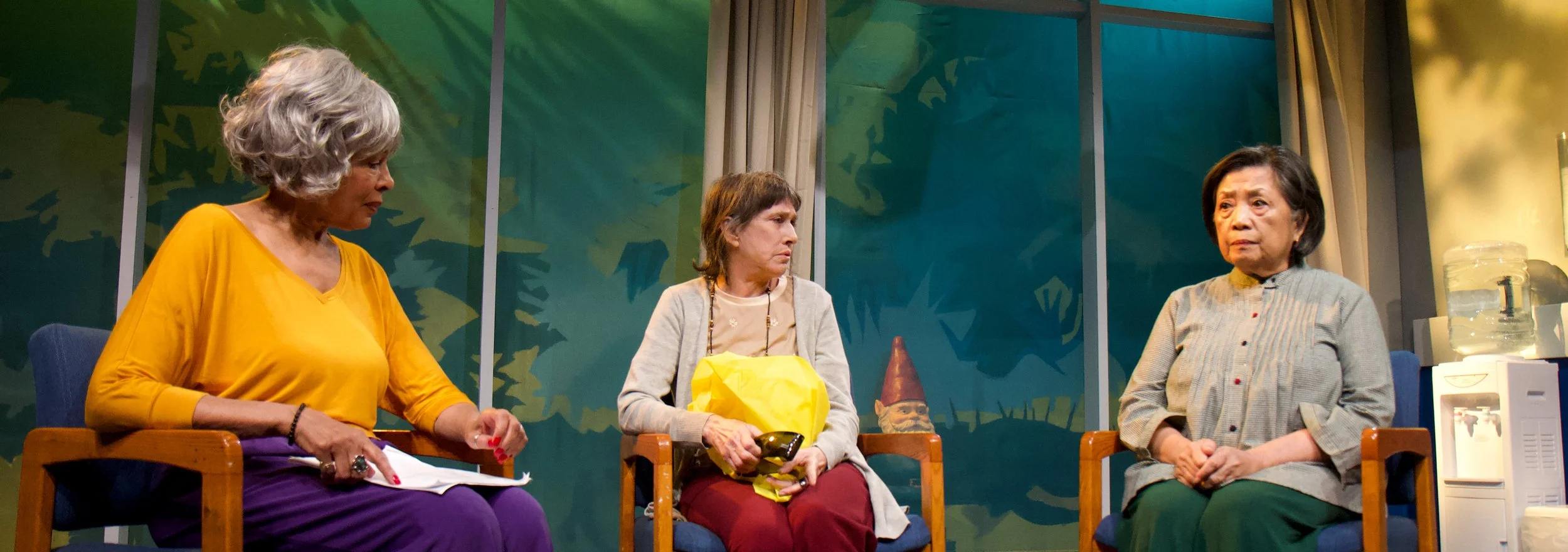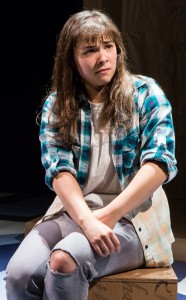Poking fun at Shakespeare has been a fruitful pastime for more than a century. George Bernard Shaw enjoyed taking the Bard down a peg in his reviews of Victorian productions. In the 1950s Richard Armour wrote cheeky synopses of the plays in Twisted Tales from Shakespeare, and in 2015 the Broadway musical Something Rotten made fun of Shakespeare himself. Now actress and playwright Talene Monahon has done her bit to twist the dagger a few more times into the playwright with an often funny and splendidly acted Jane Anger.
See You
If nothing else, the Bridge Production Group deserves a shout-out for tackling difficult material. Just 10 minutes into a mere 70 minutes’ running time, See You, by Canadian writer Guillaume Corbeil, is more than likely to provoke thoughts of how swiftly mortal lives are over, and whether your own demise will occur before the play ends. In short, See You is a stultifying, irritating work—playwriting by lists.
Madame Lynch
Eliza Lynch is Paraguay’s version of Eva Perón, Argentina’s famous class-climbing first lady. Madame Lynch, as she was known, was born in Ireland, emigrated with her family to France during the Irish Potato Famine (1845–49), and became a highly admired courtesan. In 1845 she met General Francisco Solano López Carrillo, who later became president of Paraguay, and she became the country’s most controversial de facto first lady. (The pair never married.) Once reviled by Paraguayans but now celebrated, the self-named “Empress of Paraguay” is the basis for the Drunkard’s Wife production of Madame Lynch, which is subtitled a “spectacle with music and dancing.”
Street Children
Pia Scala-Zankel’s 2014 play Street Children captures a small slice of life for gay and transgender kids on the streets, and features an ensemble of transgender, queer and gender-fluid actors. Set in the late 1980s around the West Side piers on the outskirts of the West Village, sex is currency in their milieu. When Jamie, played skillfully by Eve Lindley, arrives for the first time at the piers, her nose has been bloodied by a trick gone bad. She’s 17 and unschooled in this world yet she has nowhere else to go. Like all the kids who arrive here, she has been rejected by her family and society at large.
No Pot of Gold
An 8,000-year-old Irish fairy is not to be mistaken for a leprechaun in James McLindon’s Comes a Faery. The production opens with a grown woman (Meghan St. Thomas) acting like an 8-year-old girl Siobhan as she plays with a doll and toy truck. Though it is noted in the script for “a very youthful-looking adult [to] play Siobhan,” the casting does not work. St. Thomas sounds and behaves like a whiny child and looks more like an adolescent who is at the beginning stages of puberty. The mismatch in casting distracts theatergoers from acknowledging St. Thomas’ solid performance and her ability to carry the production. The director Shaun Peknic could have taken the liberty to cast a younger woman to portray the child Siobhan. On the other hand, Josh Marcantel is well cast as the Irish fairy Seaneen. Comes a Faery attempts to capture the emotional and mental impacts that a child experiences when their mother is away overseas serving in the armed forces.
The play takes place in an apartment in Cambridge, Massachusetts and the set design by Kyu Shin is modest and homely with a loveseat, lamp and nightstand. In the background appears to be a wooden stage with three boxes wrapped in beige paper that have light cursive writing. The brown coloring used for the wording is not dark enough to clearly understand what is written. The two large walls on the backstage appear to be a large book and they also have the beige paper with brown wording on them. The light and dark blue and white zebra print floor is distracting and it does not exactly match the blue and white blankets on the couch. The audience members were further distracted from the actors’ performances when a cockroach ran across the stage and St. Thomas killed it by dropping a book on the cockroach. Marcantel tried to sweep the dead cockroach under the stage with his foot, and the experience left a lasting impression with the audience.
Siobhan is fixated on seeing her mother again and is easily manipulated by Seaneen, who has convinced Siobhan that everyone in her life will leave her. Seaneen is never clearly defined as actually being a real, live fairy or Siobhan’s imaginary playmate. This is one example of how McLindon leaves it up to audiences to decide for themselves if Seaneen is real or not. The lack of clarity does not add much to the plot or Seaneen’s character development and actually creates confusion. Siobhan’s pediatrician Dr. Neery (Lori Kee) cannot clearly diagnose Siobhan’s condition or Siobhan’s relationship with Seaneen. When Seaneen convinces Siobhan to catch Dr. Neery on fire with a burning newspaper, Dr. Neery writes off Siobhan’s failed attempt and says, “That which doesn’t kill you makes for a great story later.” Dr. Neery believes that Siobhan could be experiencing conduct disorder or possibly psychosis. Siobhan’s guardian and Aunt Katie (Michaela Reggio) thinks that it is normal for 8-year-old girls like Siobhan to have an imaginary Irish fairy as a best friend. Katie’s artist boyfriend Raphael (Benjamin Miller) is Siobhan’s only healthy, male role model and he appears to be the only person who can actually relate to her.
The value of the production rests in its opportunity to have a greater conversation about children who are raised by others while their biological parents serve in a war. However, the lack of clarity and confusing casting has McLindon fall short in clearly delivering a message. Simply leaving it up to theatergoers to decide what is happening or what the point is, suggests that the material is underdeveloped. The show runs for 120 minutes with an intermission and feels like it lags. A matured production will have theatergoers wanting more and not just waiting for the show to end so that they can go home.
Comes a Faery misses it mark and does not deliver to its full potential. The production would be much more powerful if St. Thomas were cast as Aunt Katie and a teenager played Siobhan. As strong performers, St. Thomas and Miller could compliment each other’s performances if they were paired together as boyfriend and girlfriend. Reggio portrays Katie as a victim of her own circumstances and instead of having theatergoers feel empathy for Katie, she occurs as annoying and tiresome to watch. Miller stands out in comparison to Reggio when they are partnered together. Miller’s energy feels like a sitcom actor. Comes a Faery is not recommended unless theatergoers are willing to overlook its shortcomings and focus on the dynamic performances by St. Thomas, Miller and Marcantel.
Comes a Faery runs until Oct. 24 at the New Ohio Theatre (154 Christopher St. between Greenwich and Washington Sts.) in Manhattan. Evening performances are Friday and Saturday at 8 p.m. Tickets are $18 and can be purchased by calling 347-524-0514 or visiting www.nylonfusion.org.












